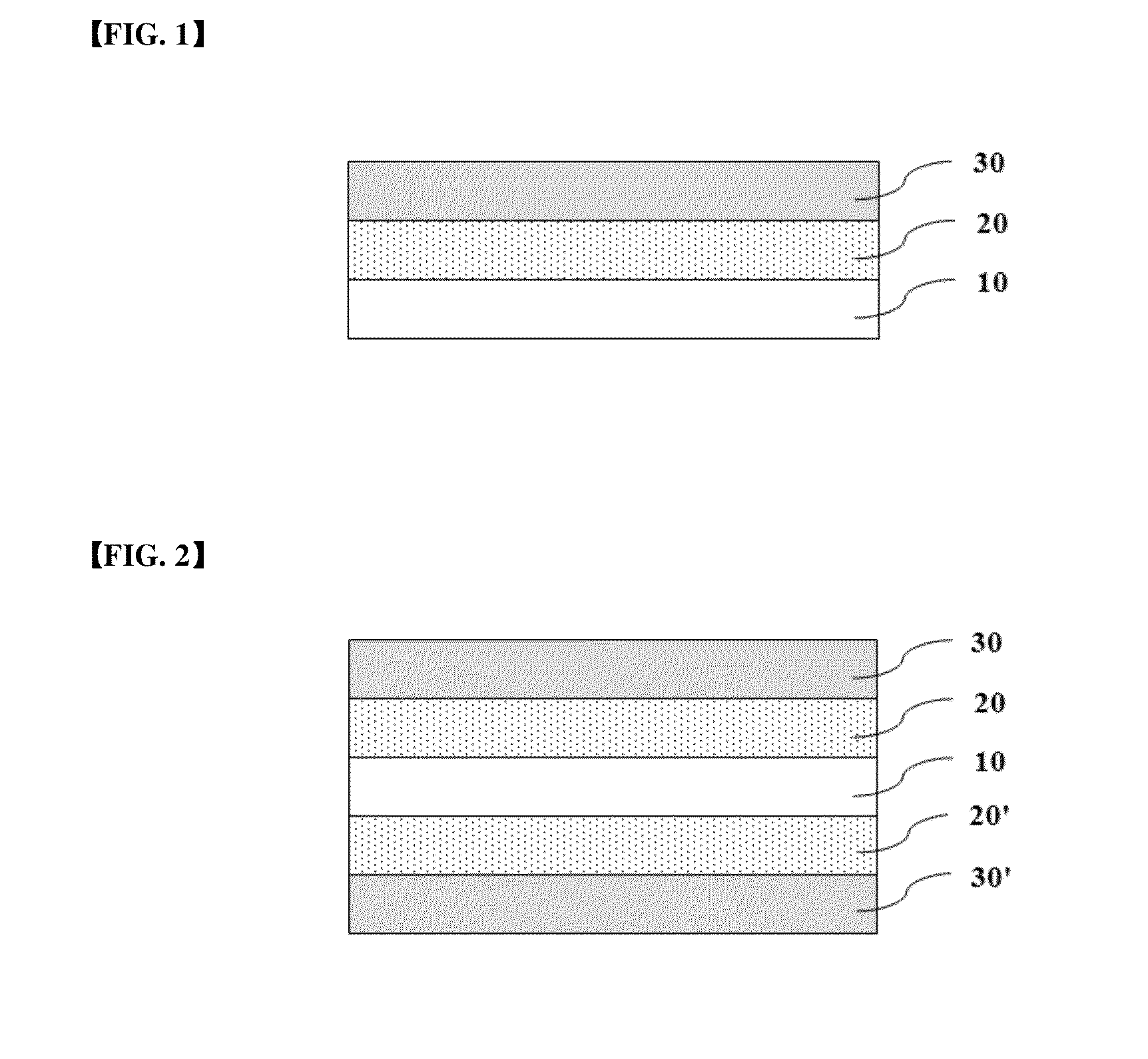Cyanate esters-based adhesive resin composition for fabrication of circuit board and flexible metal clad laminate comprising the same
a technology of adhesive resin and cyanate esters, which is applied in the direction of synthetic resin layered products, elastomeric polymer dielectrics, film/foil adhesives, etc., can solve the problems of lowering the dielectric constant and the dielectric loss factor of laminates, and achieves enhanced electrical characteristics, low dielectric constant, and low dielectric loss factor
- Summary
- Abstract
- Description
- Claims
- Application Information
AI Technical Summary
Benefits of technology
Problems solved by technology
Method used
Image
Examples
example 1
[0083](Preparation of Adhesive Resin Composition)
[0084]Polytetrafluoroethylene (PTFE) powder (LUBRON manufactured by DAIKIN, number average particle diameter: about 0.5 μm) and a polyester-based dispersing agent are added to toluene and then dispersed uniformly with a homogenizer (15,000 rpm).
[0085]A cyanate ester resin is added to the mixture at the content ratio (based on 100 parts by weight of the cyanate ester resin) given in Table 1 and then completely dissolved with an agitator. To the mixture is added a solution containing 20 wt % of styrene butadiene rubber dissolved in toluene under agitation. Subsequently, cobalt naphthalate as a cyanate ester curing accelerator is added and sufficiently blended into the mixture to prepare a cyanate ester resin composition in which the fluorine resin powder is dispersed.
preparation examples 6 to 10
[0094](Fabrication of Coverlay)
[0095]Each composition according to Examples 1, 2 and 3, or Comparative Examples 1 and 2 is applied onto the one side of a polyimide film (manufactured by KANEKA, 12.5 μm thick) by coating to a dry-film thickness of about 25 μm and dried out at about 150° C. for about 10 minutes. Then, a 100 μm thick release paper (EX3 manufactured by Lintec) with a release coating is laminated on the dry film to fabricate a thermosetting coverlay.
[0096]PREPARATION EXAMPLES 11 TO 15
Fabrication of Prepreg
[0097]An about 25 μm thick NE glass fiber is impregnated with each composition according to Examples 1, 2 and 3, or Comparative Examples 1 and 2 and then dried out at about 150° C. for about 10 minutes to fabricate a thermosetting prepreg with the total thickness of about 50 μm.
preparation examples 16 to 20
[0098](Fabrication of Double-Sided Flexible Copper Clad Laminate)
[0099]Each composition according to Examples 1, 2 and 3, or Comparative Examples 1 and 2 is applied onto the one side of a polyimide film (manufactured by KANEKA, 12.5 μm thick) by coating to a dry-film thickness of about 10 μm to form an adhesive resin layer, which is then dried into the semi-cured state. The above-stated adhesive resin layer is also formed on the other side of the polyimide film in the same manner to prepare an adhesive sheet.
[0100]Subsequently, a copper foil (manufactured by FUKUDA; thickness: about 12 m, roughness (Rz) on the Matte side: 1.6 μm) is laminated on both sides of the adhesive sheet. The resultant laminate is compressed at about 180° C. under the pressure of 30 2 5 kgf / cm2 and then cured at about 170° C. for about 5 hours to obtain a double-sided flexible copper clad laminate.
PUM
| Property | Measurement | Unit |
|---|---|---|
| number average particle diameter | aaaaa | aaaaa |
| thickness | aaaaa | aaaaa |
| dielectric constant | aaaaa | aaaaa |
Abstract
Description
Claims
Application Information
 Login to View More
Login to View More - R&D
- Intellectual Property
- Life Sciences
- Materials
- Tech Scout
- Unparalleled Data Quality
- Higher Quality Content
- 60% Fewer Hallucinations
Browse by: Latest US Patents, China's latest patents, Technical Efficacy Thesaurus, Application Domain, Technology Topic, Popular Technical Reports.
© 2025 PatSnap. All rights reserved.Legal|Privacy policy|Modern Slavery Act Transparency Statement|Sitemap|About US| Contact US: help@patsnap.com


